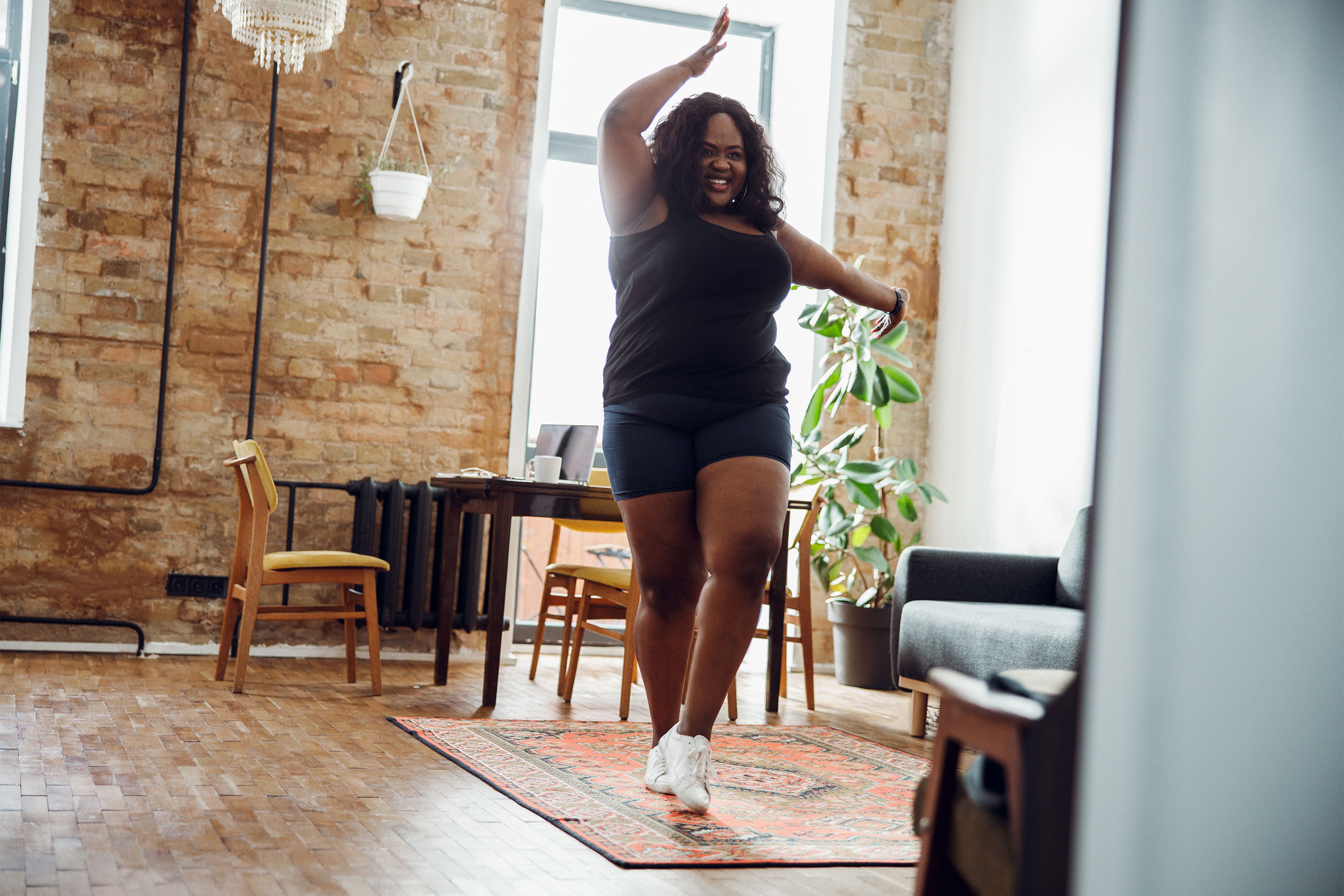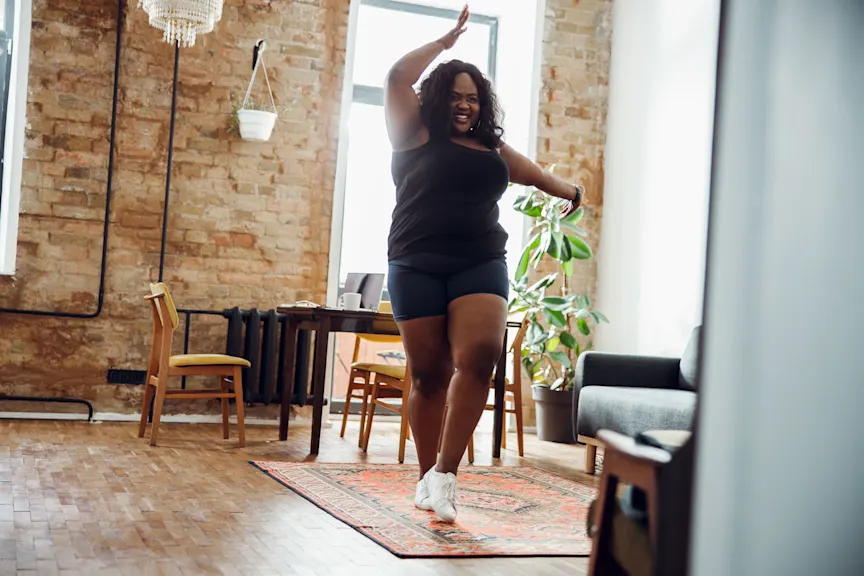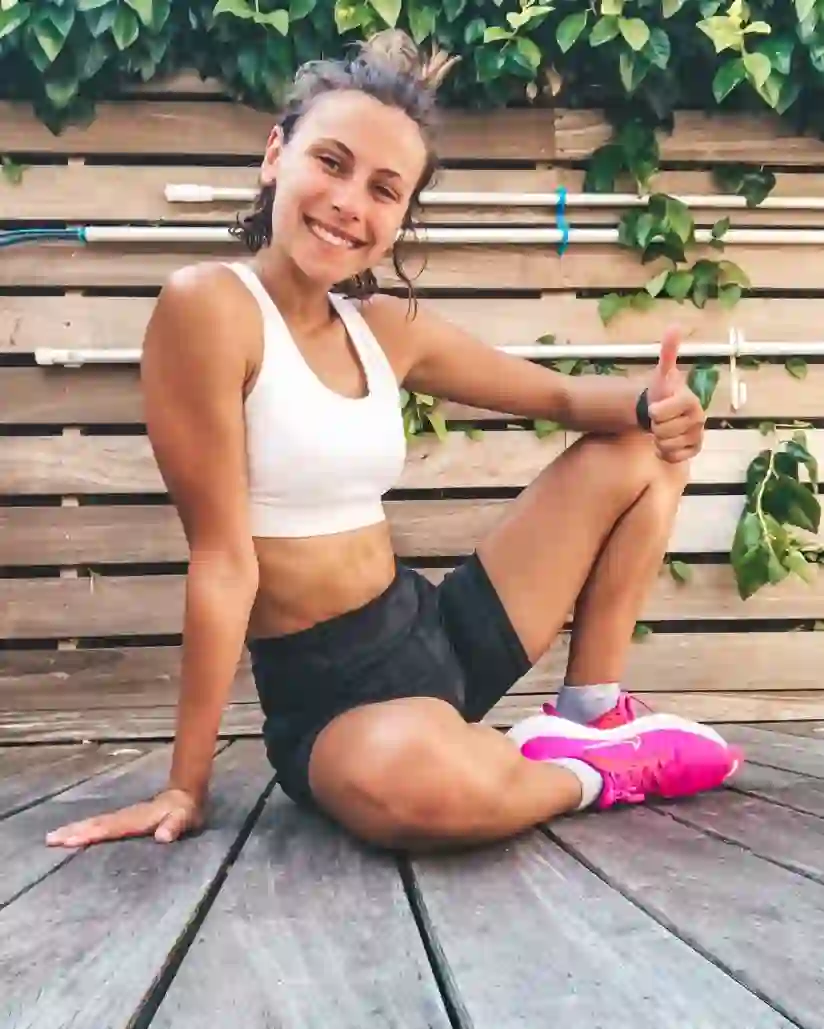Daily Exercise Plan for Rheumatoid Arthritis

Start the year off with some feel-good movement and momentum. This do-anywhere, for-everyone plan is too small to fail!

Happy 2023! We’re glad you’re here for some motivation and information to hit the ground … stepping and repping. This month’s Dream Big challenge is designed for, well, anyone looking to build a fitness habit. It’s super doable and provides just the right jumpstart for a year (or dare we say, a lifestyle) of making your body stronger. The moves you’ll do were created with a specific nod to those with rheumatoid arthritis (RA), so they’re joint-friendly. And don’t worry—this is no bootcamp. The program will get you up and exercising each and every day with compact, 5-minute workouts along with some walking or your choice of cardio (grooving to music in the living room, anyone?).
What you’ll get out of it: According to the American College of Rheumatology, people with RA who exercise regularly experience less pain, more energy, improved sleep, and better day-to-day function. Working out also improves cognition, reduces anxiety, and aids depression, and can lift your overall quality of life. Sounds simple—and maybe even contradictory since moving the joints which are causing that pain is probably the very last thing you want to do—but your body will thank you.
How do we know? Your coach on this journey is an #RAWarrior herself who learned firsthand what an elixir exercise could be after the chronic inflammatory condition nearly sidelined her in her early 20s. In fact, by implementing the low-key approach of building in daily movement—just like you’ll be doing here—she got hooked, and eventually became a personal trainer in order to help others find that secret sauce for themselves. Let’s meet Alexandra “Ali” DiGiacomo.
Meet Your Coach
Ali DiGiacomo, Certified Trainer and #RAWarrior

Courtesy of Ali DiGiacomo
DiGiacomo was poised to be a swimming superstar. In high school, she competed in two junior Olympics and was planning to go to college on an athletic scholarship. But one day during a water polo practice, DiGiacomo was having trouble staying above water. When she got out of the pool, she found that her knee was twice its normal size.
“The doctors drained the fluid from my knee, and after an MRI, they discovered a benign mass behind my kneecap,” she says. “They did surgery to remove the mass, and afterward the doctor told me that my joint looked like that of a 60-year-old.” At age 15, DiGiacomo was diagnosed with rheumatoid arthritis.
Being so young, DiGiacomo didn’t think much about her diagnosis. She had never heard of the disease, and even though she had to give up swimming, she wasn’t in pain and didn’t need medication. “It’s safe to say I was also in denial,” she adds.
However, that all changed after college. “I was working as a production assistant in the film industry and was on my feet all day,” she says. “My RA came back aggressively and I was struggling just to walk. I tried to hide my pain, but you could see how swollen my knee was even through my jeans!”
DiGiacomo had her knee drained every week for seven weeks in a row. After her seventh visit, the rheumatologist refused to drain it again. “She told me that I ran the risk of infection if I continued to get it drained, so I started taking medication,” says DiGiacomo. “I had been putting it off, partly because I was still in denial, but it helped me feel better pretty much right away. I was able to walk again!”
Though she felt better physically, DiGiacomo still struggled with anxiety and depression. “It was difficult for me to navigate this disease because I didn’t know anyone else my age who had it,” she says. In 2018, DiGiacomo started an Instagram account called @anotherdaywithRA with the hope that it could help her connect with a few others in her same situation, and to bring awareness to her disease.
One of those initial connections inspired her to start exercising. DiGiacomo committed to four weeks of consistent activity, and she soon realized that this was what had been missing for her for years. Exercise didn’t drain her of energy and it wasn’t painful. In fact, it did the exact opposite and DiGiacomo had energy to spare, less pain, and a brighter outlook on life. She continued to exercise and chronicled her journey on social media under the Instagram handle @anotherdaywithra. The number of people who reached out to her for help with working out inspired DiGiacomo to become a personal trainer, and today she is certified with the National Academy of Sports Medicine.
Week 1: Ease in With Micro Workouts
Ready? Your 28-day countdown starts now! Sure, it’s going to be a commitment to check off a workout every day, but this beginner’s plan is the easy-does-it blueprint that DiGiacomo followed herself to keep moving through her RA symptoms. The week ahead consist of three types of movement—cardiovascular activity, strength training, and mobility exercises—with just a trio of bodyweight-only moves to do on those mobility (a.k.a. stretching) and strength days. Here’s why that mix matters when you’ve got RA:
Cardiovascular Activity
Cardio is anything that gets your heart consistently pumping a little faster, and according to a recent study published in BMC Sports Science, Medicine & Rehabilitation, aerobic exercise can relieve pain, boost energy, and improve function in those with RA. It also can help improve your mental outlook and alleviate depression, according to research in the Irish Journal of Medical Science. Low-impact activities such as walking, swimming, hiking, cycling, and even dancing are great for those with RA. “Dancing has always been my go-to cardio workout,” says DiGiacomo. “It’s fun and easy to do and I always have a smile on my face when I finish.”
Strength Training
Resistance training helps strengthen the muscles around your joints, helping support your body and reduce pain. “Bodyweight exercises are the perfect way to start strength training,” says DiGiacomo. “Your body weighs something! Just try to do 30 seconds of arm circles and see how it burns!”
Mobility Exercises
According to the Arthritis Foundation, stretching is one of the best ways to alleviate stiffness in your joints and promote better movement patterns. You can also do activities such as yoga or tai chi to mobilize your body in new ways. “I advise people with RA to stretch every day, if they can,” says DiGiacomo. “I like to do it before I work out to help my range of motion.”
Now that you’ve got the benefits down, let’s get to it.
Week 1 Training Plan
Day 1: Cardio
Take a 20-minute walk.
Day 2: Strength Training—Upper Body
Before your strength and mobility workouts, try to do five minutes of light activity to warm up your muscles and get your blood flowing.
-
Arm Circles: Extend your arms straight out to the sides at shoulder height. Do 10 small circles backward, then 10 small circles forward. Repeat two times.
-
Isometric Palm Presses: Place the palms of your hands together in front of your chest, fingers spread. Actively press your palms together for one count, then release. Repeat 10 times.
-
Air Curl/Extension: Extend your arms in front of you at shoulder height, palms facing up. Keeping your upper arm steady just as it is, bend your elbows and slowly bring your fingertips to touch your shoulders. Return slowly to the start. Repeat 10 times.
Day 3: Stretching
-
Ankle ABCs: Sit in a chair with your feet flat on the floor. Extend one knee so your leg is straight. Write the alphabet in the air with your foot. Repeat with other leg.
-
Sit and Reach: Sit tall in a chair with your feet flat on the floor. Extend your right arm overhead by your ear and grip the seat with your left hand. Reach up and over to the left as far as you can and hold for 10 to 20 seconds. Return to the start. Repeat on the other side. Complete 2 rounds.
-
Seated Spinal Twist: Sit tall in a chair with your feet flat on the floor. Place your left hand on the outside of your right knee and your right hand on the back of the chair. Twist and look over your right shoulder and hold for 10 seconds. Return to the start. Repeat on the other side. Complete two rounds.
Day 4: Cardio
Put on your favorite music and dance for 15 minutes.
Day 5: Strength Training—Lower Body
-
Stand-Up, Sit-Down: Sit on the edge of a sturdy chair with your feet flat on the floor about hip-width apart. Lean forward slightly and stand up off the chair, trying not to use your hands to help. Slowly sit back down, controlling your movement as much as possible. Repeat 10 times.
-
Hinges: Stand with your feet hip-width apart, knees slightly bent, and place your hands on your hips. Keep your back straight and hinge from your hips to fold forward like a jackknife. Go as far as you can without rounding your back, then stand back up. Repeat 10 times.
-
Side-Lying Leg Lifts: Lie on your right side with your head resting on your right arm. Bend your bottom knee and extend your top leg straight. Make sure your hips are stacked one on top of the other; don’t lean forward or backward. Slowly lift your left leg up as high as you can and pause briefly. Slowly lower to the start. Do 10 reps on each side.
Day 6: Cardio
Take a 20-minute walk.
Day 7: Stretching
-
Cat-Cow: Get on all fours on the floor with your hands under your shoulders and your knees under your hips. Drop your chin to your chest, tuck your tailbone under and round your back up like a Halloween cat. Hold briefly then return to the start. Next, look up, drop your belly toward the floor and arch your back. Hold briefly, then return to the start. Repeat sequence five times.
-
Knee Drops: Lie face-up with your knees bent and feet flat on the floor. Extend your arms out to the sides, palms down. Slowly drop your knees to the left and hold 10 seconds. Return to the start. Repeat on the right. Complete three rounds.
-
Open the Book: Lie on your right side with your knees bent and legs stacked. Extend your arms in front of you on the floor, palms together. Keep your knees and hips in place as you open your left arm and twist as far as you can to the left. Hold 20 seconds. Return to the start. Repeat twice more, then do the other side.
Set Yourself up for Success
First things first: As with starting any new exercise program, get the okay from your doctor before you dive in. Then, give it your commitment. DiGiacomo knows from her own experience with rheumatoid arthritis that when you’re in pain, the last thing you may want to do is to get up and move around. Check in with your body, and if it’s your usual RA aches, she encourages you to power through for the payoff on the other side.
“Week 1 will be the most challenging, especially mentally,” says DiGiacomo. “When I started out, there were things I could not do because of my condition and pain. But even if I was flaring, I would talk myself into doing something—anything—to get moving, even if that meant doing a little stretching in bed. I always, always felt better afterward, and that gave me motivation to continue the next day.” Checking off that first month was sort of a revelation to DiGiacomo which led her to string together more workouts. Those workouts slowly progressed with her level of fitness—and her confidence in her body’s ability. “So, yes,” she says. “You’ll make a ton of excuses as to why you can’t exercise, but being consistent is imperative.”
Here are some of her tips to make kick-starting your journey a little easier.
-
Get an accountability buddy. “Find someone—or a group of someones—who are passionate and ready to do this challenge with you,” says DiGiacomo. “If you can find someone else who has RA, that would be ideal.” Not sure where to connect with a buddy? “Go to one of my social media channels on Instagram or TikTok,” she says. “The community here is amazing, and I even have a highlight reel of all my friends that are willing to help.”
-
Prepare for success. Every night, set out everything you’ll need to exercise the next morning: clothes, socks, underwear, and shoes. “As soon as you get up, even before you brush your teeth, get dressed and make sure you put on your shoes,” says DiGiacomo. “If you have shoes on, you can’t get back into bed!”
-
Work out first thing in the morning. “If you do your exercise right when you get up, you won’t be able to make any excuses throughout the day,” says DiGiacomo. “You’ll also have more energy and better focus.”
-
Make exercise fun. “Play your favorite tunes and dance around the room, go for a walk outside, or do a workout video on YouTube,” says DiGiacomo. “If it’s fun, you’ll look forward to it, not dread it.”
-
Give yourself a break. Everyone has hard days or flare-ups. “In these cases, call or text your accountability buddy to help get you moving,” says DiGiacomo. “If you’re still not motivated, dance in bed or in a chair, or simply do a little stretching. Remind yourself you’ll feel better afterward.”
You can do this. Check off your workout boxes daily and we’ll see you next week with more exercises and encouragement to keep you moving forward. Before you know it, you’ll have a one-week exercise streak under your belt and be ready for more.








